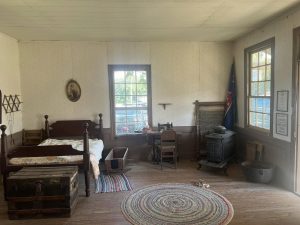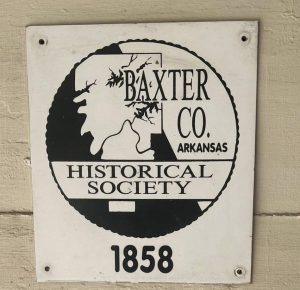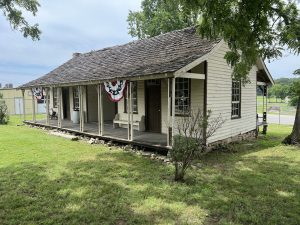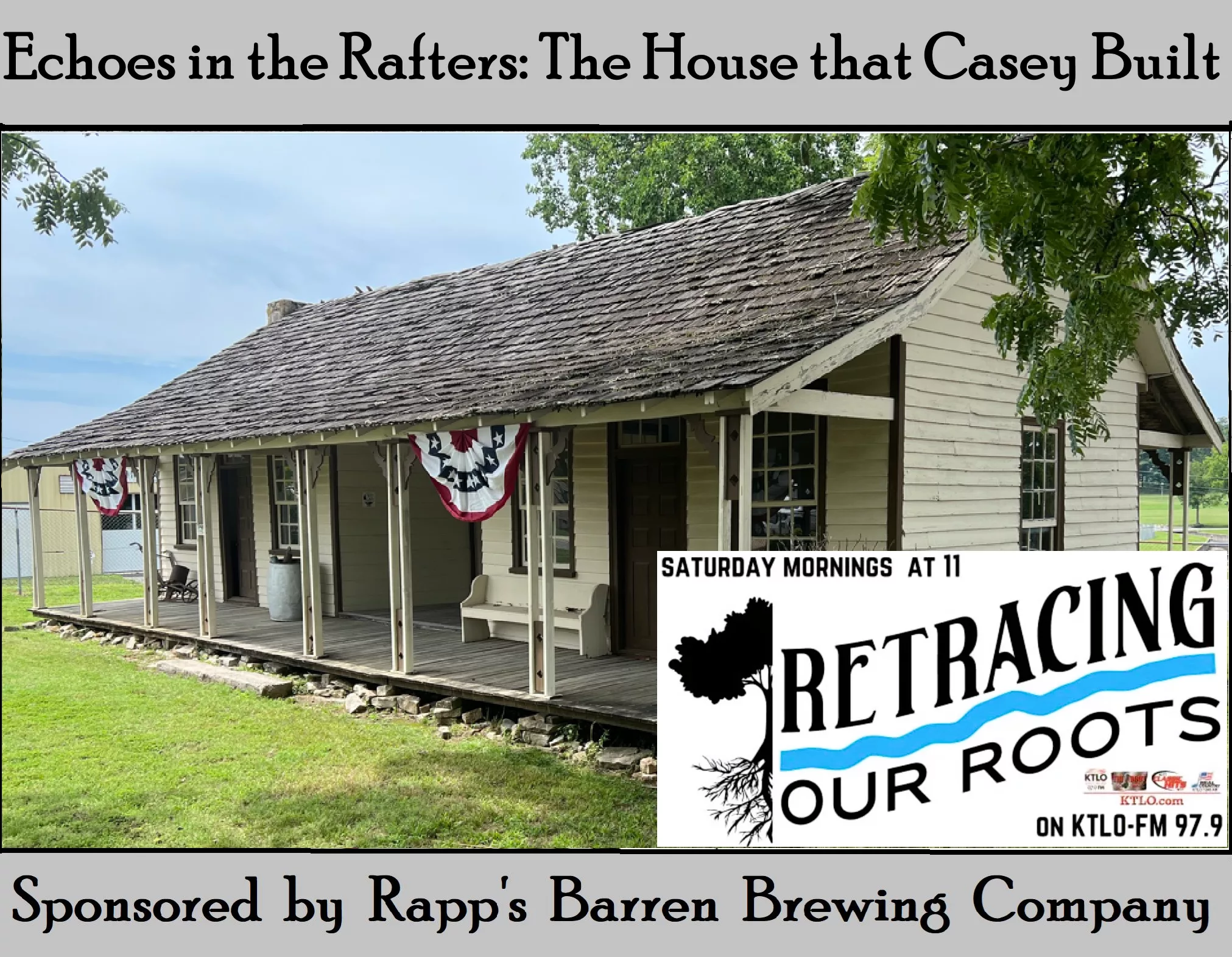Retracing Our Roots #34
Echoes in the Rafters: The House that Casey Built

Welcome to another fascinating episode of Retracing Our Roots. This week, Sammy Raycraft and Vincent Anderson visit the oldest house in Mountain Home, Arkansas, the Randolph D. Casey House.
The Casey House is the oldest surviving structure in Mountain Home, Arkansas. Still perched on the exact spot where it was built, the house is a gift from the past, reminding us that history lives not only in books, but also in hand-hewn wood, native stone, and the silent memories etched into old walls.
As a young lieutenant, Casey served in the 124th Tennessee Militia during the Trail of Tears in February 1838. He remembered the beautiful valley just off the ridge of the Military Road, now known as the Old Military Road and the Trail of Tears crossing 201 South.
Twenty years later, Casey returned to Rapp’s Barren to build the area’s first house made of milled lumber, a marked departure from the typical log cabins of the era. Built in 1858 by Mr. Casey for his mother, this two-room "dog-trot" cabin was skillfully crafted and sturdily constructed. It has withstood the trials of the Civil War, a near-devastating tornado in 1985, and the slow wear of time. Remarkably, most of the structure, including its foundation stones, remains original, though some new wood was added during repairs after the storm.
The cabin has witnessed the transformation of Baxter County, the growth of Mountain Home, and the development of the nearby fairgrounds. During Casey’s time, several outbuildings stood nearby, but those are long gone.
Randolph Casey was born in Tennessee in 1810. After losing his first wife, Gilla Dean, in 1857, he moved to Arkansas with his widowed mother, Catherine. His two married daughters remained in Tennessee.
Ran Casey was following in the footsteps of his younger brother, Dr. John Casey, who had earlier settled along the North Fork River near the pioneering Jacob Wolf. The two-story Wolf House—now a beloved historical landmark—still stands in Norfork. Dr. Casey eventually married Jacob Wolf’s daughter.
Looking to push farther west, Randolph (Ran) and his mother journeyed by steamboat up the White River, disembarking at Buffalo. From there, they traveled by wagon to the growing settlement of Rapp’s Barren, now Mountain Home. “Ran” Casey opened a small general store. It sold essentials like salt, sugar, cloth, and gunpowder, and it doubled as the post office. Though the store is gone, the house he built nearby stands as lasting proof of a promise he made to his mother: that she would never again live in a log cabin.
The Casey House was quite advanced for its time, featuring two porches, a stone fireplace, and even glass windows. You can still find Casey’s initials and the date "1858" carved into the exterior chimney.



Inside, the home tells a vivid story of frontier life—from the elegantly carved mantel to the snug, well-fitted wooden floors. Originally, each room had its own fireplace, though only one remains. The wide dog-trot provided cooling breezes during hot summers and served as extra living space in all but the coldest months. Framed with squared-off logs and clad in painted pine siding, the lumber was milled and planed in Batesville, then shipped upriver to Shipps Ferry and hauled by wagon to its final destination.
During the Civil War, Casey served as in the Confederate Army and fought at the Battle of Pea Ridge.
While home on leave, October 16, 1862, Casey was captured by Union troops passing through the Mountain Home area on an unauthorized raid. The story goes that with a noose around his neck, Casey made a secret Masonic sign to the Union captain, who happened to be a fellow Mason. The captain ordered his release and spared the house from destruction. Additionally, Confederate, Major J. W. Methvin was captured by Union forces at the Casey house in Mountain Home, Arkansas, just one day shy of reaching home after a six-day journey from Pocahontas while gravely ill with pneumonia. Methvin was first taken to Springfield, Missouri, and later transferred to St. Louis, where he succumbed to pneumonia and died in captivity.
In 1873, Baxter County was carved from neighboring counties, and Casey played a key role in establishing its government. County court was held in his store, for which he received $7.00 a month. Around the same time, Dr. John Casey arrived in Mountain Home and opened its first combined general store, pharmacy, and post office on what would become the town square.
In 1879, Randolph Casey married Elizabeth Smith, who was much younger. He died in 1896, leaving behind three sons under the age of ten. Casey is buried in Mountain Home Cemetery, alongside members of both his family and the Wolf family, two clans closely intertwined through marriage and shared history.
By 1909, the Casey family had moved out, and the house changed hands several times, falling into disrepair. By the 1950s, the property was part of the fairgrounds, yet no preservation efforts were made. It wasn’t until locals Lloyd Fisk and Neil Nelson bought the building that the tide turned. In 1971, they persuaded the county to purchase the cabin for preservation. A modest federal grant in 1976 provided $800, most of which went toward fencing to deter vandals.
The Baxter County Historical Society stepped in to fund a new roof and other crucial repairs. Most of the labor was donated. Antique materials were salvaged from other old structures being torn down, including parts of the Wolf House, which was undergoing restoration at the same time.
Today, the Historical Society maintains artifacts in the Casey House, and the 27th Arkansas Infantry Camp 1519 Sons of Confederate Veterans give tours of the Casey House to students during the Baxter County Fair.
We tip our hats to Rapp’s Barren Brewing Company for their steadfast support of Retracing Our Roots. This is what true local programming looks like, where shared stories knit a community together. We couldn’t keep history alive without the heart and help of folks like Rapp’s.
Next time you find yourself in Mountain Home, stop in at Rapp’s Barren Brewing. Shake the hand of Russell Tucker and his top-notch team—and let 'em know you appreciate their part in preserving Ozarks’ history, one tale at a time.
Sip. Savor. Sojourn. — Retracing Our Roots
Got a buried tale or backwoods legend we ought to uncover?
Drop us a line—we’re all ears.













